
Craiova is the largest city in southwestern Romania, the seventh largest city in the country and the capital of Dolj County, situated near the east bank of the river Jiu in central Oltenia.

Suceava is a city in northeastern Romania. The seat of Suceava County, it is situated in the historical regions of Bukovina and Moldavia, northeastern Romania. It is the largest urban settlement of Suceava County, with a population of 84,308 inhabitants according to the 2021 Romanian census.

"ASTRA" National Museum Complex is a museum complex in Sibiu, Romania, which gathers under the same authority four ethnology and civilisation museums in the city, a series of laboratories for conservation and research, and a documentation centre. It is the successor of the ASTRA Museum that has existed in the city since 1905. Its modern life started with the opening of The Museum of Folk Technology in 1964, now The "ASTRA" Museum of the Traditional Folk Civilization.

The University of Craiova is a public university located in Craiova, Romania. It was founded in 1947, initially with four institutes, in the Palace of Justice of Craiova. It is the largest university in the historical Oltenia province of Romania. It was the last university established in the Kingdom of Romania. It was the fifth university in Romania officially approved by the Ministerial Council of the Socialist Republic of Romania in 1965, with seven faculties: Mathematics, Philology, Electrotechnics, Agriculture, Horticulture, Chemistry and Economics. The university is a member of the European University Association. It currently includes a total of 16 faculties and two colleges for undergraduate and postgraduate programmes.

The Museum of Dacian and Roman Civilisation is a museum in Deva, Romania. A brief history of Deva and its other neighbouring citadels as well as extensive archaeological discoveries from the numerous sights in and around the Orăştie Mountains are exhibited in the museum.
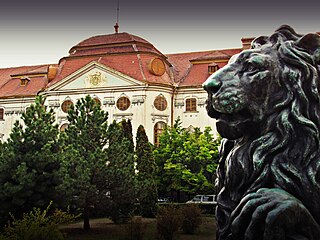
The Baroque Palace of Oradea, also known as the Roman Catholic Episcopal Palace of Oradea, of the city of Oradea in Bihor County, Romania, is a building that dates to the Baroque times.
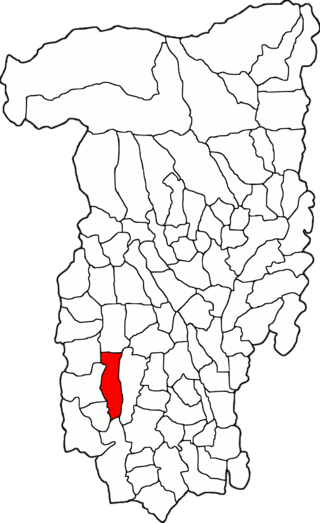
Tetoiu is a commune located in Vâlcea County, Oltenia, Romania. It is composed of seven villages: Băroiu, Budele, Măneasa, Nenciulești, Popești, Tetoiu, and Țepești.

Piatra-Olt is a town in Olt County, Oltenia, Romania. The town administers five villages: Bistrița Nouă, Criva de Jos, Criva de Sus, Enoșești and Piatra. The town is an important railway station and road intersection. It officially became a town in 1989, as a result of the Romanian rural systematization program.

Constantin S. Nicolăescu-Plopșor or Nicolaescu-Plopșor, sometimes shortened to N. Plopșor, was a Romanian historian, archeologist, anthropologist and ethnographer, also known as a folkorist and children's writer, whose diverse activities were primarily focused on his native region of Oltenia. A student and disciple of Vasile Pârvan at the University of Bucharest, he had a youthful activity collecting and publishing Oltenian songs and poetry, being the first to document Romanian folklore as produced during the peasants' revolt of 1907, and committing to writing the regional variants of Miorița ballad. Increasingly interested in the Balkans' prehistoric period, he researched various Paleolithic, Mesolithic, and Neolithic sites in his native country, placing them in a larger European context while producing his own systems of Prehistoric chronology and typology. His main contributions to archeology include the classification of Oltenian microliths, the study of local cave paintings, and the disputed claim that a site in Tetoiu evidenced a regional contribution to anthropogenesis.

The Ethnographic Museum of Transylvania is situated in Cluj-Napoca, Romania. With a history of almost 100 years, the Ethnographic Museum of Transylvania is one of the first and greatest of its kind in Romania. It has two exhibition sections, one of which is to be found in downtown Reduta Palace, while the other exhibition section is the open-air Romulus Vuia Park situated on the city's north-west side, in Hoia Forest.
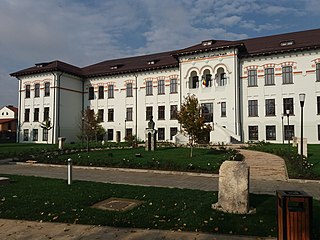
The Iron Gates Region Museum is a museum in Drobeta-Turnu Severin, Romania.

The National Museum of Banat is a museum in Timișoara, Romania, headquartered in Huniade Castle. It was founded in 1872 by the Society of History and Archeology of Banat on the initiative of the prefect of the then Temes County Zsigmond Ormós. It hosts the largest collection of archeological objects in Banat. The ground floor houses the 6,200-year-old Parța Neolithic Sanctuary. The museum includes departments for archeology, history and natural sciences. The museum also has a laboratory for conservation and preservation of objects of cultural heritage and history.

The Cathedral of Saint Demetrius is a Romanian Orthodox cathedral, see of the Metropolis of Oltenia. It is located at 14 Matei Basarab Street, Craiova, Romania, in the historic region of Oltenia. There was likely a church on the site by the 1490s, renovated in 1651 and, having fallen into disrepair, demolished in 1889. That year, work on a new church began, and this was completed and sanctified in 1933. The earlier church's close proximity to the headquarters of the Ban of Craiova gave it importance in the city's political life, as well as a defensive purpose, while the modern building's role ensures its continued significance.

Dimitrie Maimarolu was a Romanian architect, whose designs featured French Beaux-Arts style.
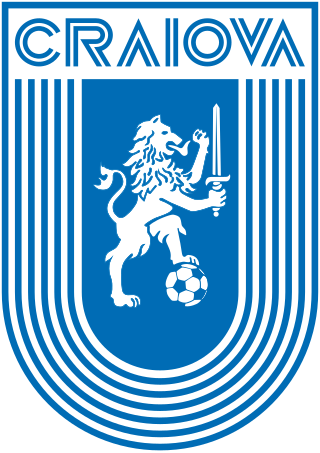
U Craiova 1948 Club Sportiv, commonly known as Universitatea Craiova, CS U Craiova, or simply U Craiova, is a Romanian professional football team based in Craiova, Dolj County. It competes in the Liga I, the top tier of the Romanian league system.

Kırklareli Museum is a national museum in Kırklareli, Turkey, exhibiting natural history specimens, ethnographical items related to the region's history of cultural life, and archaeological artifacts found in and around the city. The director of the museum is Derya Balkan.

The Craiova Art Museum is an art museum in the city of Craiova, Oltenia, Romania.
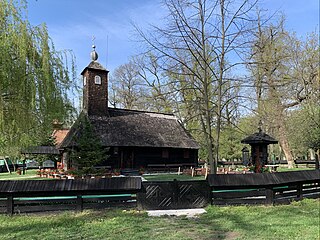
The Banat Village Museum is an open-air ethnographic museum in northeastern Timișoara, at the edge of the Green Forest. Spread over an area of 17 ha, the museum is designed as a traditional Banat village and includes peasant households belonging to various ethnic groups in Banat, buildings with social function of the traditional village, folk art installations and workshops.

















